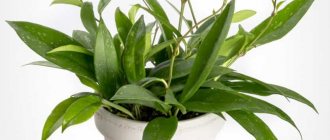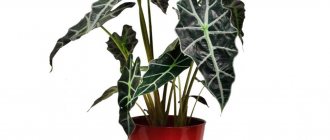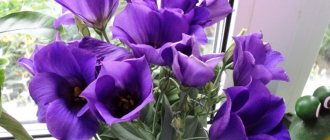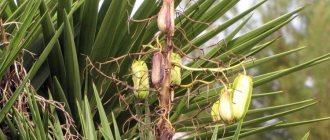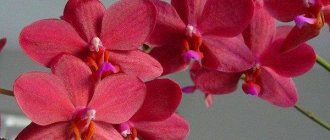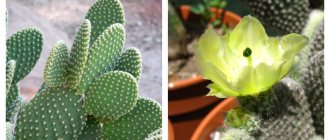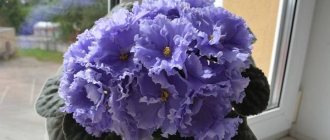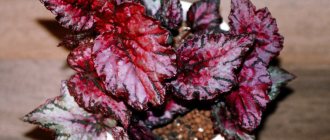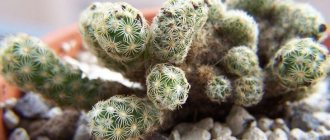What is Hoya afraid of: pests and diseases
A plant that is constantly watered may suffer from root rot or powdery mildew.
The first disease kills the plant, especially since by the time you see its manifestations (rotting stem, wilted leaves - everything, as in the photo above), the root system may already be completely lost.
Powdery mildew (whitish coating) can be effectively combated. First, trim off all infected leaves and spray the bush with a purchased fungicide. Remove the top part of the soil and add fresh soil.
Sometimes the plant is attacked by harmful insects. They can be “picked” from an open window, from a bouquet brought into the house (even if you grew the flowers yourself in a flowerbed), or from a new flowerpot infected in a store.
Pests can be different:
- Spider mite. This tiny dark creature is difficult to see, but if there are a lot of mites, a sticky web appears on the plant. Such reptiles are afraid of high humidity (you can even place a container of water near a hanging pot so that it evaporates) and store-bought poisons. “Actellik” has proven itself well (in our case, you need to dilute it, giving 15 drops per liter, and spray the plant, and repeat this procedure a week later, even if you no longer see insects).
- Scale insects. Brown spots, hard to the touch. Wash the hoya leaves with cotton pads dipped in soapy water. Does not help? I'll have to buy karbofos.
- Mealybug. It is identified by the presence of a whitish coating. In this case, you can cope with natural methods - for example, onion or garlic infusion.
Pests will not attack if the hoya is frequently sprayed, and the air near it does not dry out.
But what if the flower cannot be cured? Or if you bought a “goddam” from a sale to save it, but it doesn’t work out? The answer is in this video:
Characteristic
The correct name of the crop is Hoya lanceolata bella. This is a tropical plant that is most often used for home cultivation, planted in hanging pots.
Hoya Bella can be distinguished by the following appearance features:
- Root system . In the plant it is small and weak. To prevent the bushes from dying, they should be grown in flat and wide containers, planting 2-3 sprouts.
- Stem . In Hoya it is thin, soft and flexible. The color is gray-green, has thick internodes and a large number of leaves. The shoots are long, cascading, and do not require support. The stems are branching, prone to rapid growth, forming large flower umbrellas at the tips.
- Leaves . Their shape is rhomboid, the edges are pointed. The length of the leaf blade is 2-4 cm. The outer side of the leaf is dark green, and the inner side is whitish.
- Flowers . Hoya bella has very beautiful flowers. Their shape resembles small white stars, inside of which there is a pink or purple crown. They are found in round umbrella-shaped inflorescences, 7-9 pieces each.
Diseases and pests
Improper care weakens the plant and can be affected by bacterial and fungal infections.
In such cases, treatment with fungicides, such as Bordeaux mixture, helps.
As a preventive measure, it is recommended to wash the leaves in the shower and optimize the living conditions.
Red spider mites, aphids, and scale insects settle on insufficiently cared for specimens. As a first aid solution, a soap solution or cotton wool soaked in alcohol is used to remove pests. Only systemic insecticides can completely get rid of them.
To prevent damage by nematodes, the soil substrate and container must be sterilized before planting. A native of exotic islands, Hoya obovata doesn't require too much.
Give it a permanent bright place, provide it with a cool winter, do not over-water it, prune it in a timely manner - and it will grow quickly, produce new glossy round leaves and bloom regularly, exuding one of those unusual aromas that the distant jungle smells of.
Popular varieties: description and photo
This species is represented by an ampelous plant. A small bush-type plant with abundantly branching and lodging shoots . The creeping stems are covered at the top with thick, small, sharp leaves 3 cm long. The small flowers are white, with a purple-red or pure red crown in the center.
The main feature of the species is small star-shaped flowers with five ends, which are collected in inflorescences of 7-9 pieces. In warm weather, droplets of nectar appear in the center of the inflorescence. Lush flowering lasts throughout the summer. This type does not have such a pronounced aroma compared to others. Below are brief descriptions and photos of ratsenyai varieties.
Bella Variegata (Beautiful Variegata)
This species has leaves with dark green edges and a light yellow center . This species is considered the most beautiful especially during the flowering period. The flower grows slowly and is demanding in terms of care.
Bella Albomarginata (Beautiful Albomarginata)
This species has leaves with white edges and a green center, 3 cm long and 1 cm wide. Flower umbrellas develop at the ends of the shoots; it blooms constantly and profusely. The core of the white flowers is light pink or soft purple, similar to a crown. The inflorescences last up to 8 days, after which they fall off along with the peduncles. Hoya blooms in May and finishes blooming in July.
Home care
Lighting
This type of hoi is more suitable for well-lit rooms with windows facing south, but it still shouldn’t be exposed to the sun for a long time: with an excess of “tanning,” the color of the leaves becomes lighter, and drying, browning areas form on them - traces of sunburn.
“Changing places” and, accordingly, changing the nature of the lighting is also an undesirable process: when rearranged, the hoya loses flowers and buds, and also sheds leaves.
Temperature
In summer, the optimal temperature range is from 17 to 25 degrees, and in winter, a rest period at a temperature of 10-15 degrees is useful.
Drafts harm the plant.
Priming
In this case, any soil is suitable - those that are quite fertile, loose, and have a neutral or slightly acidic reaction.
Hoya obovata grows well in ordinary garden soil, and in universal soil from the store, and in a mixture of leaf and turf soil with peat, humus and sand, in which all ingredients are taken in equal proportions.
Landing
The landing container should not be too large, with a mandatory drainage hole.
Old pots from other plants are not suitable for planting hoya; The new container must be washed thoroughly.
Before planting the plant, a drainage layer (expanded clay, small pebbles, brick or ceramic scrap) is placed at the bottom of the container.
Then a small amount of soil is poured, and the root system is placed on top of it, with, if possible, a lump of earth preserved.
For spectacular growth and flowering, it is useful to plant several young plants in one pot.
Add soil mixture to the desired level, carefully compacting it. Provide support for growing stems
Provide support for growing stems.
Transfer
Young hoyas are replanted every year, adult specimens - once every 2-3 years or less.
Replanting should, in fact, be a transshipment that preserves the old earthen ball as much as possible, and the new pot is chosen not to be too spacious.
Soon after purchase, the plant is replanted, since before sale, for better presentation, hoyas are usually supported with stimulants. With such a transplant, the substrate is also removed from the root system and in this case the earthen ball is not preserved.
Watering
Between the arrival of moisture, the earthen lump should dry out; Excess, and even more so, stagnation of moisture is unacceptable.
During cool wintering, watering is carried out even less frequently.
Top dressing
During intensive growth and during the flowering period, hoyas of this species, especially young specimens, can be occasionally fed with complexes for flowering succulents or with a significantly diluted solution of universal fertilizers.
Trimming
Potentially, such a climbing vine can live for decades and quickly grow stems 10 meters long. In indoor culture, its growth must be limited by spring pruning and pinching.
In addition, shortening an actively growing shoot stimulates the development of lateral buds and, accordingly, the density of foliage and the splendor of flowering.
In practice, after the fourth leaf the shoot can be cut or pinched.
The flower stalks are not removed, as new inflorescences will develop on them over time.
Bloom
Hoya flower - what the varieties Carnosa, Kerry, Bella, fleshy, Multiflora look like
Hoya Bella, with good care, will delight its owners with abundant flowering for a long time.
The flowers are collected in inflorescences of nine flowers. They are white or pink in color, star-shaped, with a bright corolla.
Hoya Bella blooming
Flower shapes
Hoya Bella flowers have a five-pointed regular shape, the petals are white or pink with pointed edges. In the middle of the flower there is a lilac-colored corolla. Flowers fill the air with a unique rich aroma.
Flowering period
The plant blooms from late May to early autumn. The flowering process is endless: old fallen buds are replaced by new ones that immediately open.
For your information! Hoya Bella blooms throughout the warm season - from late May to early September.
Changes in care during the flowering period
During flowering, the plant behaves quite capriciously. Hoya cannot be moved to another place; it should be protected from temperature changes and drafts. In a new location, the plant may stop blooming, and a change in light levels will lead to the buds withering and the flower petals falling off.
Hoya Bella does not need any additional pruning. Faded inflorescences do not need to be touched, as fruits will soon appear on them, and new buds will also develop on old peduncles.
Is it possible to keep Hoya at home?
Most often, Hoya is grown not in apartments, but in offices and studies, and the reason for this is superstition. For a long time, people believed that wax ivy survives the husband’s family and drives adult sons out of the house. Other, no less convincing sources claim that hoya relieves feelings of resentment and pacifies envy. There are publications that say that hoya is “a plant of family happiness, it is advisable to place it in the bedroom.” What to believe? Maybe it’s worth trying to grow hoya at home and clarify the degree of its influence on a person’s destiny? You decide. I see in hoya only a cozy plant with beautiful flowers, caring for which is a pleasure.
Varieties of indoor plants with photos
Due to the fact that listing all 50 varieties is too long, we decided to present to your attention several of the most popular types. We present to you all the variety of tropical hoya, its features and benefits.
Bella
The main distinguishing feature of the plant is its flowers, which are small but very delicate. Inflorescences of this variety are collected in an umbrella, of which there can be seven or nine pieces. In the hot season, inside such an inflorescence there may be a drop of sweet and aromatic nectar, which is a bait for bees.
Bella originated in one of the provinces of China, as well as in Indonesia. The most abundant flowering occurs from May to September, that is, in the summer it is at its peak. Bella also has a second name - Bella the Beautiful.
Kerry
This plant achieved its popularity due to a certain beauty in the shape of the foliage. This is justified by the fact that each leaf has the shape of a heart. Very often this particular variety is sold in high demand before Valentine's Day.
In many flower shops this variety can be found under the name “Green Heart”, which, together with a beautiful pot, can serve as a wonderful gift.
There is also another name for Kerry, because it is also popularly called Hoya Valentine.
Fleshy
This plant is already playing the role of a shrub, which can cling to a support very actively and presentably. The flower got its name because its foliage is very fleshy and not small, its oval shape. The flowers in this case are waxy and rather plump, with a diameter of 10 mm.
The color of this variety can be pink or purple. As a separate species, such a plant is very widely used in the field of breeding, because it is extremely easy to cross with other direct species. It was precisely because of the fleshy Hoya that there were definitely many hybrids.
Lacunosa
This variety is more of an epiphytic plant, because it is special in that it quickly begins to flower. In the natural environment, this flower has a certain relationship with ants.
This is justified by the fact that these insects quite often choose a home near the Lacunosa root. The main feature is the diamond-shaped leaves, but at the same time their surface is not entirely smooth, as it has small depressions in the area of the veins.
Due to all the features, this variety is popularly called concave.
Matilda
This variety is more of a hybrid, because it was produced by crossing Serpentes and Carnos. The main distinguishing feature of the hybrid is its long stems, which are one and a half centimeters thick. The foliage is oval in shape and covered with silver dots.
The flower stalks create a very wonderful aroma around the perimeter. The hybrid blooms throughout the whole year.
Linearis
It’s worth noting right away that this variety is more commonly found among people under the name linear Hoya. This species can be found extremely rarely in standard terrain, because the climate that is best suited for this variety is in the Himalayas. The foliage has a light green color, and the variety itself grows as vines, the length of which can reach up to six meters.
The linear plant can emit a wonderful vanilla scent during its flowering period, but it is extremely rare to detect it. Very often this variety is compared to a lily for its aroma.
Gracilis
This variety has a second name - Graceful Hoya. The foliage has an oval shape, which is also quite oblong. The color of the foliage is also light, as in the previous variety; there are spots on the surface that are extremely rarely noticeable.
Important! We recommend reading the article about caring for the hoya plant, as well as interesting facts about it.
Retuza
Popularly you can find this variety called Compressed Hoya. The foliage is thin in shape and also elongated. The flowers are extremely beautiful and have a delicate white color. The middle of the peduncle has a purple color. The aroma is extremely identical to the smell of lemon.
Tricolor
The second name of the variety is even more complicated - Hoya carnosa tricolor, or, more simply, a tricolor plant. The main distinguishing feature is the combination of three different colors.
The main color is white, but in the area of the roots green begins to predominate, and the veins are pink at the same time.
Polyneira
This variety has a high concentration of veins. A shrub of this format can grow extremely quickly, which has a positive effect on the interior where the plant is installed. Some experts note that this flower will look beautiful as a hanging flower pot.
Article on the topic: Photo of streptocarpus snow-white, stem, cornflower, johansky
The foliage has the appearance of a diamond, but at the same time has veins that are clearly expressed and have a blue-green color. Such veins, in some of their parameters, resemble the tails of beautiful overseas fish. If you properly care for the plant, you can ensure that it blooms all year round.
Meliflua
This variety is a vine with long vines. The variety is distinguished by the fact that it grows extremely quickly. If he grows in his natural conditions, he will be able to gain about four meters in height. Thus, it becomes clear that Meliflua needs to be properly pruned and cared for. This is especially true when growing plants at home.
The foliage has a glossy finish, and the leaves themselves may differ in size from each other; there are pronounced veins. The flowers are pink in color and have a distinct scent.
Compacta
A distinctive feature is small foliage with a twisted shape. In many stores this plant is sold as an independent plant, but a large number of floriculture experts believe that it is a species of Hoya carnosa.
For the first time, Compacta received the status of a separate plant from a specialist named Burton. He found a distinctive feature of Compacta from Hoya carnosa. This difference was that Compacta has a special shape of internal type crown petals.
This plant is in demand among flower lovers due to the fact that it does not require special care.
Obscura
The variety has a second name - dark Obscura. The variety was bred at the beginning of the 20th century by such a specialist as Elmer. The foliage is of a standard shape, green in color, and contains very visible veins. The peduncle is pink in color, and the petals are curved in the other direction.
Blue eyes
The foliage of this variety is large in size and because of this it has a drooping appearance. Stems are woody and climbing. The peduncle is relatively elongated and holds a spherical umbrella.
Caudata
This is a climbing vine whose foliage has the appearance of an egg. Foliage length is from 9 to 14 cm. It takes root well at home, but subject to full compliance with proper planting and care.
Pachyclada
It is a so-called epiphyte with drooping shoots, the length of which is 7 cm. The peduncles are small in size, and the inflorescence has 20 flowers.
Lazianta
A few years ago, such a plant was called Plocostemma lasiantha. Its homeland is Indonesia or Malaysia.
The plant displays the appearance of a bush with thin pattern leaves. This foliage has a covering in the form of gray dots. The flowers have a bright orange appearance.
Australis
The name was given to the plant in honor of its homeland - Australia. The plant was discovered by a specialist named Joseph Banksom.
The leaves of the plant have a glossy coating, the shape of which can be completely different. The veins on the foliage are very abundant. At a young age, shoots may be red. The diameter of the flowers is two centimeters.
Tsangi
This variety was identified as an independent plant in 1991. The plant's homeland is the Philippine Islands. The plant is distinguished by the fact that the foliage is diamond shaped.
Obowata
The popular name of the plant is very interesting - Obovata tselistna. The foliage of the plant is thick, without any veins. Umbrellas have about 30 petals. The aroma is similar to that of a rose.
Imperialis
The plant was first found in Malaysia. It contains long loops that can reach up to seven meters in length.
Kurtisi
This type of plant can also be called Hoya pruinosa (Snow Hoya). The flower is a small-leaved epiphyte that has aerial roots.
The foliage of the plant is small in size, and the petioles are relatively short, but at the same time very thick and diamond-shaped. The peduncles are not long in shape, and the umbrellas are rather convex.
Hoya: propagation at home
The happy owners of an adult vine have no shortage of planting material. Its crown needs periodic shaping, and all formed but excess shoots can be easily rooted. If there is already a hoya in the house, the question of how to propagate is usually not worth it.
Blooming Hoya fleshy
How does it reproduce
Stem layering and cuttings are the main planting material. Much less often, the vine is propagated by seeds, since they are not so easy to obtain. Hoya flowers remain on the petioles for up to 2 weeks after blooming. They are bisexual, but to set seeds they need the help of pollinators, for which they secrete a lot of thick sticky and strong-smelling nectar.
Propagation by cuttings
Young shoots of this year are not suitable for propagation. Only last year's ones are suitable, and they must have at least 2 pairs of leaves. Cut them off between the knots with a sharp knife. After this, the cutting is left for 1-2 hours so that the cut dries.
For your information! Hoya nodules contain root hormones, so it is from them that the cutting will expel the roots.
There should certainly be several nodules on the cut shoot. This increases the chances of successful rooting. However, there are usually no particular difficulties with this; the vine is exceptionally resilient, and its cultivation is an interesting activity.
Rooting
The most common way to root cuttings is in water. To do this, take a container that does not transmit light. It is covered with cardboard or foil. Cuttings are inserted through the cut holes. The leaves are removed from the lower node and immersed in water. To speed up the root formation process, the cut is first dipped in a root solution.
Hoya cuttings cut for propagation
Successful root emergence requires warmth and high humidity. The optimal temperature is 22°C. If the leaves begin to wither, this indicates dry air. To correct the situation, the container with the cuttings is covered with a glass cap or plastic bag to obtain greenhouse conditions.
After 2 weeks, a sufficient number of roots should form to make it possible to transplant the cuttings into a pot. The technique is quite painstaking, so many people prefer to cut more cuttings and simply keep them in a warm, not too brightly lit place, regularly adding water.
The second method of rooting is cuttings in the substrate. The soil is purchased with a neutral alkaline reaction. The top must be covered with a cap, which is lifted once a day to spray the cutting with water. High humidity and sterile soil are the main components of success.
Step-by-step instructions that will help you root a Hoya cutting with a guarantee of success:
- A shoot that is too long is bad; 2-3 pairs of leaves are enough. If possible, it is worth rooting several shoots.
- Small-leaved varieties are planted in pots horizontally or at an angle to cover several nodes at once (up to 10 pieces) with soil. Large-leaved cuttings are sprinkled with soil only on 1 node.
- The temperature should be maintained at a stable 22°C.
- We must not forget about daily spraying.
- The chances of success remain as long as the shoot remains green and has at least 1 leaf.
Important! Cuttings placed in water should not be touched too often, because young roots are very fragile
Hoya - care and cultivation from leaves
If you can’t get a cutting, but there is at least 1 leaf, you can try to root it too. This is the most difficult path, but not hopeless. When the petiole is immersed in a nutrient substrate, the survival rate of such material is low, since plants grown at home have too little of their own supply of substances necessary for growth.
Leaf rooting
Rooting hoya from a leaf is a painstaking task, so you should follow a few recommendations:
- Chemicals are used to stimulate root growth. They are applied in the form of a solution, dripping from a pipette onto a leaf so that the liquid flows down the petiole;
- without petioles, leaves take root several times worse;
- There is a little secret: the leaf is immersed in loose soil at an angle of 45°.
How does it reproduce
In practice, several methods of breeding hoya are used. Propagation by cuttings is most often used.
Germination of seeds
For germination, seeds are planted in the ground in a plastic container. They are covered with film and provided with regular watering. In two weeks, sprouts will appear. They need to be seated apart from each other. A week after this, the plant can be planted in a permanent place.
Rooting cuttings
The use of cuttings is the most popular option for flower propagation. It is necessary to cut 3-4 cuttings from the shoots in the spring, separating them at the internodes. The bottom pair of leaves is removed. The cuttings are placed in a container with soil and watered regularly. The appearance of roots should be expected in 2-3 weeks.
On a note! It is recommended to place the container in a well-lit place and provide a daily temperature of 25 degrees Celsius.
By layering
To do this, select a shoot, lightly cut it and wrap it in moss. Regular watering is necessary. After two weeks, the root system will begin to grow at the site of the cut. After this, the sprout is disconnected and planted in a permanent place.
Hoya: description of species and flower care - Healthy Garden
Many gardeners strive to plant hoya, an interesting climbing plant. The flower has interesting umbrellas of flowers, which it manages to show off over a long period of time. But before planting, you need to familiarize yourself with all the features of the plant and the rules for caring for it. Only after this should we begin planting work.
Description of the Hoya plant
Hoya takes its origin from evergreen climbing shrubs and vines. The plant originates from the Kutrov family, from the Lastovnevy subgenus. Under natural conditions, the shrub grows on the coasts of Australia, Asia and the tropics of Polynesia.
Decorating an apartment with hoya
In most cases, a climbing flower gets along better in open forests, where it picks up a tree and completely entwines its trunk. In its homeland, there are more than 200 species of various shades of this representative of the flora.
In the wild, the vine reaches more than 10 meters in length. Shoots that are not distinguished by green cover have a purple coating. They are considered young shoots. As they grow older, their color changes to green, they acquire leaf blades and aerial rhizomes. At an older age, the green vine becomes woody.
The foliage has an oval shape. When it first appears, it gives off a smoothness and glossy shine. Over time, its tone changes to matte. The foliage is medium-sized - reaches 8 cm, width does not exceed 5 cm.
Hoya inflorescences are small, reaching 1-2 cm. They are collected in lush umbrella-inflorescences. The most common are white, pink, and crimson. Each of the flowers looks like a small star with a core that differs from the general structure and color.
The plant produces a very fragrant and persistent odor. It is especially noticeable at night.
A large number of different species are divided into 3 types:
- Erect;
- Ampelous or hanging;
- Weaving, entwining the support.
In addition, the following are the most common varieties of hoya among floriculture lovers:
- Waxy or fleshy - requires support, stretches up to 6 m. The flowers are very fragrant, white or pink. The leaf plate is large, oval in appearance with a wax coating (Tricolor, Compact and Variegate);
- Beautiful - with indescribable perfect flowers. Grows as a hanging shrub;
- Multi-flowered - the foliage is oblong and linear, twining around the support. The predominant flowers are yellow in shape with arched spurs;
- Majestic - the foliage is leathery, oblong, oval in shape, up to 20 cm in length, slightly pubescent. The inflorescences are collected in bunches of 5-10 pieces and emit a wonderful aroma.
Thus, with its splendor, hoya outshines even the most exquisite representatives of the flora. But the domesticated culture cannot boast of an abundance of flowers and bush lushness. Growing requires certain conditions for caring for the bush.
Plant care
- In order for Hoya to develop qualitatively and delight with its appearance, great efforts and constant monitoring are required.
- The following rules should be followed for a comfortable stay for a capricious beauty:
- Lat. Hoya
Lighting – lighting should be adjusted for each type of hoya.
One variety likes the sun's rays to hit it only in the morning, while another prefers the soft influence of the sun in the evening. Therefore, until you find the right lighting, you can repeatedly burn the tender young leaves.
It is important that midday bright rays do not affect the plant; there is a possibility of getting burns;
Temperature – in summer the shrub will tolerate air temperatures up to +260C. In the winter months, for beneficial development, it is not recommended to reduce the temperature to +150C. In this case, the hoya will bloom constantly, periodically replacing one panicle with another fresh umbrella-inflorescence. The main thing is not to reduce the temperature in the room to +100C. This will stop all flower development;
Watering is the main factor in the growth of hoya. It should be carried out in moderation, but so that the soil never dries out or is significantly moistened. If water passes through the soil and excess accumulates in the pan, it is recommended to pour it out. It can cause root rot or fungus to attach to the substrate;
Soil - the first planting should be carried out in specially selected and specifically prepared soil.
To do this, you need to take peat, fresh humus and medium-sized river sand in 2 equal parts, as well as turf soil in 3 parts. After mixing the composition, you should give the soil looseness.
Additional addition of charcoal and small pieces of tree bark is suitable for this.
Transfer
It is recommended to replant Hoya Bella immediately after purchase. A mixture of purchased soil for orchids and sand is suitable as a substrate. You can try preparing the soil yourself. To do this you need:
- 2 parts of turf land;
- 1 part compost;
- 1 part peat;
- 1 part sand;
- a little sphagnum and charcoal;
- crushed pine bark.
High-quality drainage must be placed at the bottom of the container. Hoya doesn’t really like transplants and has a hard time with them, so one every 3 years is enough. It is carried out in early spring before the onset of the growing season. Since the root system of the plant is rather weak, it is replanted using the transshipment method, that is, together with a lump of earth:
- pour a little soil into a container slightly larger than the previous one;
- carefully place the flower in it;
- The rest of the soil is carefully added on top.
Hoya linearis - description, cultivation, photo
Hoya linearis (Hoya linearis)
Hoya linearis is a very rare, almost epiphytic species that came to us from the highlands of the Himalayas.
Linear light green foliage, almost white on young shoots. Very long lashes (up to 6 m) are covered with narrow, 0.5 cm wide, lanceolate leaves about 5 cm. The leaves are slightly pubescent.
As a true mountain weed, this Hoya prefers coolness, partial shade and high humidity. If the air is too dry and hot, its leaves curl into tubes.
This species needs abundant watering. The soil must be constantly moist.
This species is very unpretentious in care and even for little effort the plant will reward you with abundant flowering.
Hoya Linearis in a hanging pot will be an exotic highlight of the collection. Low requirements for lighting allows you to place it away from the window. Long stems will help create a living flowering wall, which can be an interesting decorative find, and just very beautiful.
In very dark rooms the plant can be illuminated. It responds well to artificial lighting.
Many small umbrella inflorescences of snow-white flowers on low stalks can cover Hoya almost completely. The inflorescences consist of 12-15 flowers and bloom at the ends of the shoots. Therefore, after flowering, it is worth pruning them slightly to stimulate greater branching and the formation of new inflorescences.
Editorial team LePlants.ru
What it looks like, what family it belongs to
Tall indoor plants: name, description with photos, use in home landscaping and care features
Hoya Bella is a representative of the Lastovnevye family. The exact name of the plant is Hoya lanceolata Bella. It has a small root system. In the wild, Hoya Bella is an epiphyte. If it is grown indoors, it is preferable to keep the plant in hanging pots. The flower feels good in a large flat container.
Hoya Bella inflorescence
Its stems are thin, flexible, and highly branched. They have a gray-green color. Internodes in the form of clearly visible thickenings. There are a large number of leaves on the shoots. During growth, the branches fall down. Flower umbrellas grow at the ends of the shoots. The foliage is shaped like a diamond. The size of the leaves is 2-4 cm. Their sides have a different color: the top is dark green, the bottom is a green whitish tint.
One of the flower varieties
Common varieties
The most popular plant varieties:
- Variegata - distinguished by a special color of leaf plates. They are green, with beautiful yellow streaks.
- Louis Buis - the leaves of this variety have a characteristic feature - a lighter central part.
- Wee - the foliage of this hoya is smaller in size compared to other varieties. They are more numerous, making the plant look fluffier. This is one of the variegated varieties.
Briefly about the history of appearance
The plant is named after the famous English gardener Thomas Hoey. He worked for the Duke of Northumberland in the early nineteenth century. Thomas had a passion for growing tropical plants in the cool British climate.
On a note! In the wild, the Hoya Bella flower is common in Thailand and Australia.
Is the flower poisonous?
The stem, flowers and sap of the plant contain a toxic substance, so it is not recommended to keep it in families with small children or pets who like to feast on plants.
Hoya flower
Description
Hoya, or wax ivy, is an evergreen plant. In rare cases it has the appearance of a bush, more often it stretches like a vine. In its natural environment, hoya grows on trees, some species grow on steep cliffs. It uses its adventitious roots to cling to the surface. Larger species reach a height of 18 meters.
The plant has succulent leaves of a simple shape, located opposite each other along the stem. Depending on the variety, foliage may vary. Their surface is:
- smooth;
- felt;
- hairy.
Flowers appear in umbellate clusters at the tip of peduncles (spurs), sometimes singly. In most species, these spurs are perennial and rarely fall off. Each flowering cycle increases the length of the peduncle. In larger species, over time it can reach 27 cm. Flowers vary in size and range from 3 to 95 mm in diameter.
All flowers are shaped like pointed stars. Some species have round or spherical petals. It is known that in the inflorescence of Coriacea there are up to 70 inflorescences, each reaching almost 2 cm in diameter. The monochromatic Hoya pauciflora compensates for the scarcity of flowers in size. They appear at any time of the year. The surface of the petals can be smooth and shiny, sometimes matte and silky. There are varieties in which the flowers are covered with large piles. As for the color palette, it is very diverse.
The flower shape is typically star-shaped, with five thick, waxy, triangular petals topped by another star-shaped structure, the crown. The color of the buds can be white, pink, yellow or orange. You can find plants with dark red, almost black or even green flowers. Many smell sweet, and most even produce nectar.
The main pollinators of flowers in the natural environment are moths, flies and ants.
The seeds are arranged in double pods. The follicles are generally lightweight and are dispersed by the wind with a small tuft of silky down. Their germination is fast, but their viability is short.
One species, Hoya linearis, has leaves that resemble string beans hanging in bunches of stems. The flower is covered with fine fluffy hairs and hangs from trees in its native habitat. Some varieties have veins on the foliage that are lighter or darker in color than the rest of the foliage. There are species with thin and translucent foliage, while others have thick and succulent foliage.
What it looks like, what family it belongs to
Hoya Bella is a representative of the Lastovnevye family. The exact name of the plant is Hoya lanceolata Bella. It has a small root system. In the wild, Hoya Bella is an epiphyte. If it is grown indoors, it is preferable to keep the plant in hanging pots. The flower feels good in a large flat container.
Hoya Bella inflorescence
Its stems are thin, flexible, and highly branched. They have a gray-green color. Internodes in the form of clearly visible thickenings. There are a large number of leaves on the shoots. During growth, the branches fall down. Flower umbrellas grow at the ends of the shoots. The foliage is shaped like a diamond. The size of the leaves is 2-4 cm. Their sides have a different color: the top is dark green, the bottom is a green whitish tint.
One of the flower varieties
The most popular plant varieties:
- Variegata - distinguished by a special color of leaf plates. They are green, with beautiful yellow streaks.
- Louis Buis - the leaves of this variety have a characteristic feature - a lighter central part.
- Wee - the foliage of this hoya is smaller in size compared to other varieties. They are more numerous, making the plant look fluffier. This is one of the variegated varieties.
On a note! In the wild, the Hoya Bella flower is common in Thailand and Australia.
Is the flower poisonous?
The stem, flowers and sap of the plant contain a toxic substance, so it is not recommended to keep it in families with small children or pets who like to feast on plants.
Hoya flower
Diseases and pests
Hoya bella practically does not get sick; in some cases, the flower may be affected by powdery mildew or root rot due to excess moisture. Treatment for powdery mildew consists of the following procedures:
- removal of leaf plates and shoots damaged by whitish coating;
- replacement of the soil surface;
- treating the plant with fungicides.
Root rot is usually incurable, since Hoya's roots are weak and die quickly. To avoid this situation, you need to be careful about watering and avoid over-moistening the soil. If you do not follow the necessary rules for caring for the plant, you can provoke the following problems:
- spots on the leaf blades can indicate both sunburn and lack of lighting; you need to change the location of the flower;
- foliage falls - excessive moisture, too cold water for watering or frequent change of flower location;
- falling flowers can occur due to drafts, incorrect temperature in the room, or movement of the plant;
- lack of flowering occurs due to poor lighting or abundant moisture in winter;
- poor growth, inconspicuous leaves indicate a lack of nutrients in the soil.
The plant can be damaged by pests: spider mites, mealybugs and scale insects. When indoor air is dry, small red dots or spider threads appear on the back of the leaves - this is how spider mites manifest themselves. Small growths on the leaf blades indicate the appearance of a scale insect, and whitish balls are traces of a mealybug.
For control purposes, the plant is washed with soapy water and treated with insecticidal preparations, for example, Actellik or karbofos.
For information on how to properly care for the plant, see below.
Care and cultivation
In order for hoya to grow actively, it is necessary to create conditions close to its natural environment. This is not difficult to do, just follow certain rules of care.
Temperature
The optimal temperature for keeping hoya in summer is 20-30 degrees. In winter, it is reduced to 12-16 degrees, this is necessary for abundant flowering in the future. This time is considered a period of rest. In summer, the room with the plant must be ventilated. But you can’t create drafts, hoya can’t stand it.
Important! Falling and yellowing of leaves is a common cause of flower hypothermia.
Choosing a location and lighting
Hoya loves bright, diffused lighting. Western or eastern window sills work well. The plant is shaded from direct sunlight during the midday hours. On northern windows, Hoya does not have enough lighting and rarely blooms.
Daylight hours are 11-13 hours, and flowering requires 12-16 hours. Therefore, additional lighting in the form of fluorescent lamps is installed in the room.
In summer, the plant can be taken out to the balcony, but it should be protected from drafts.
